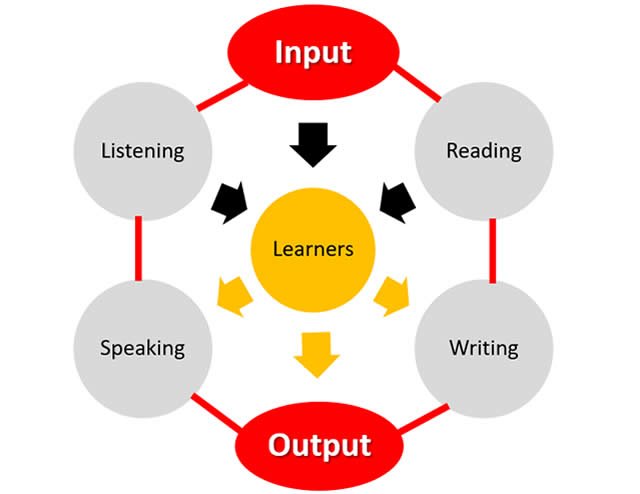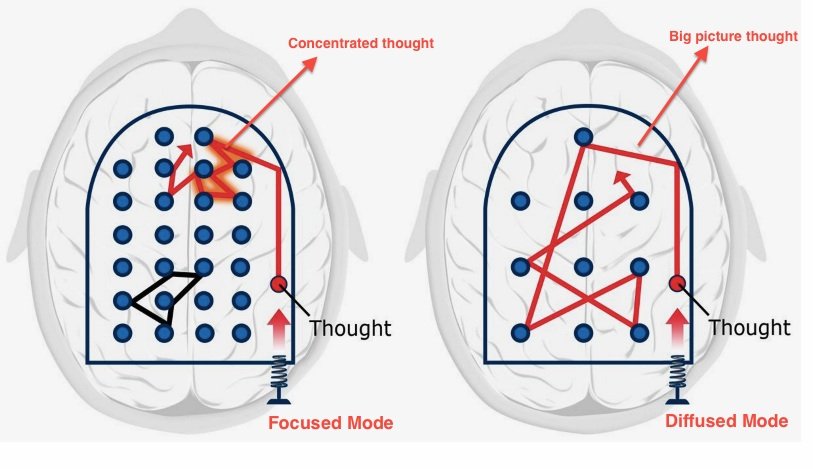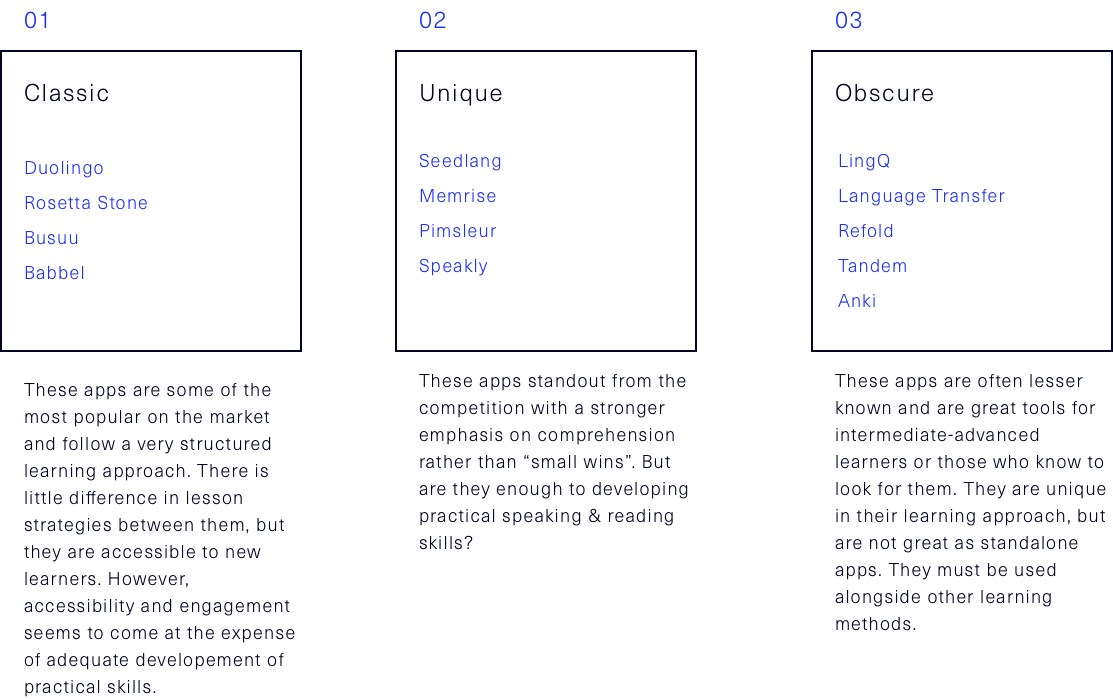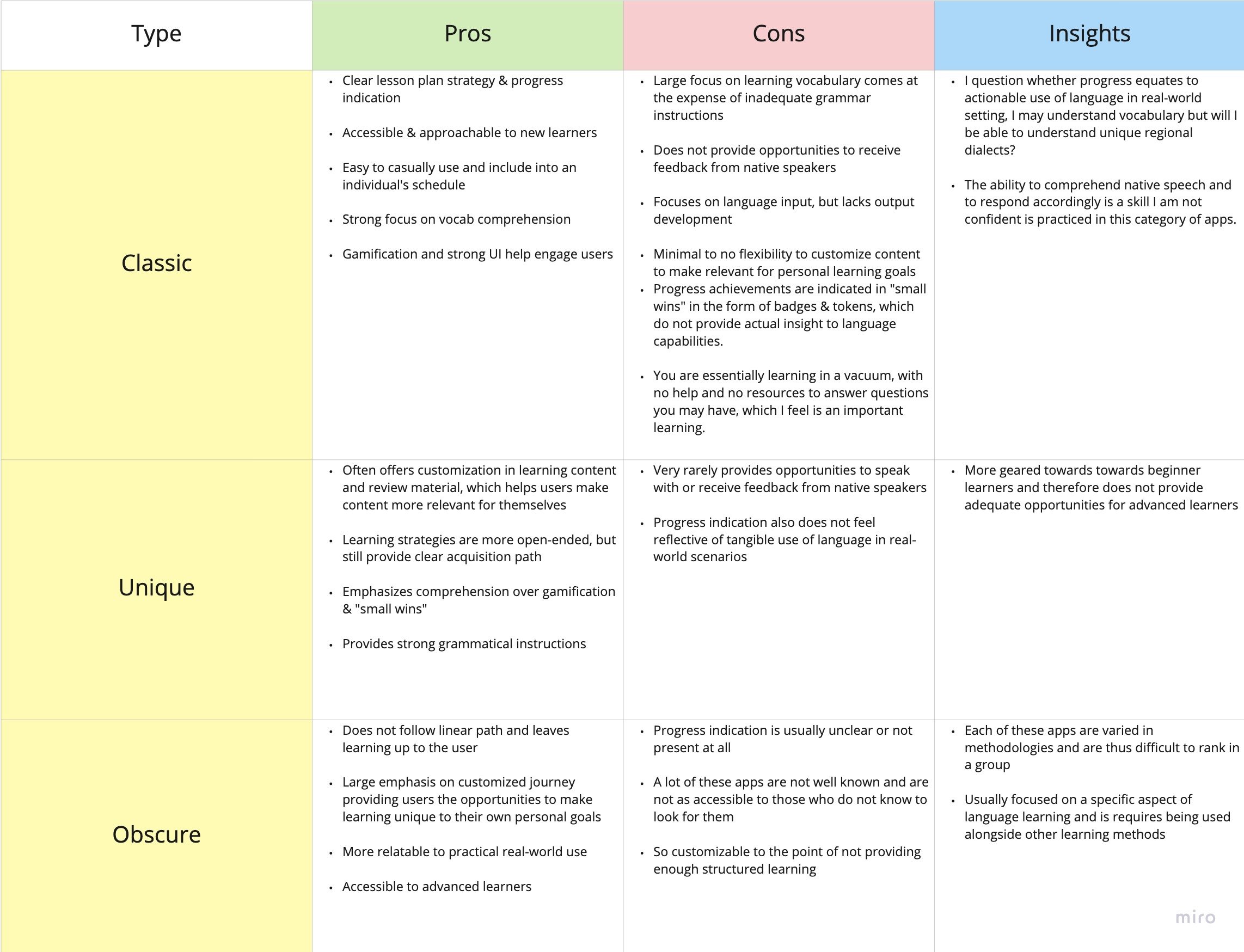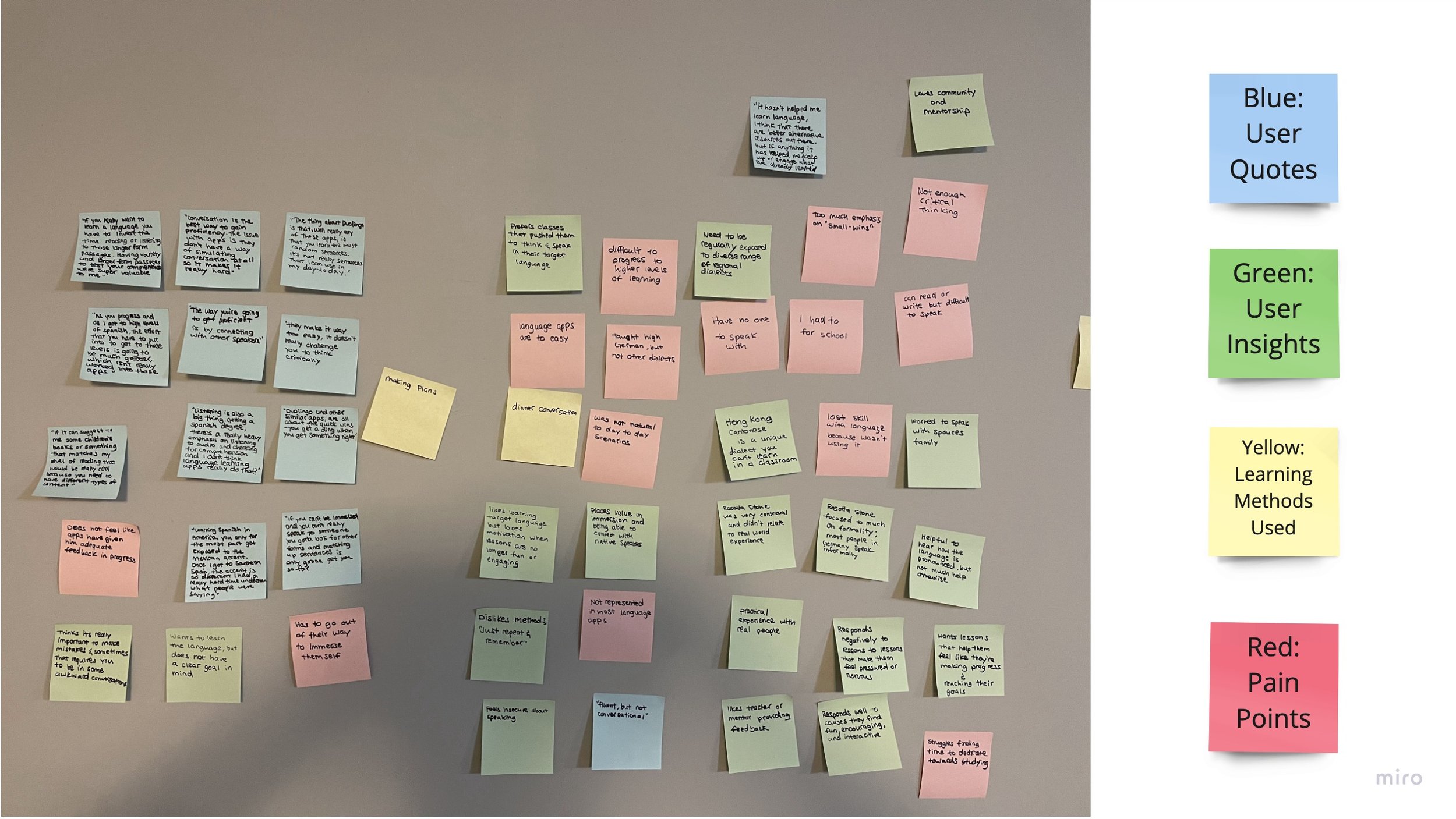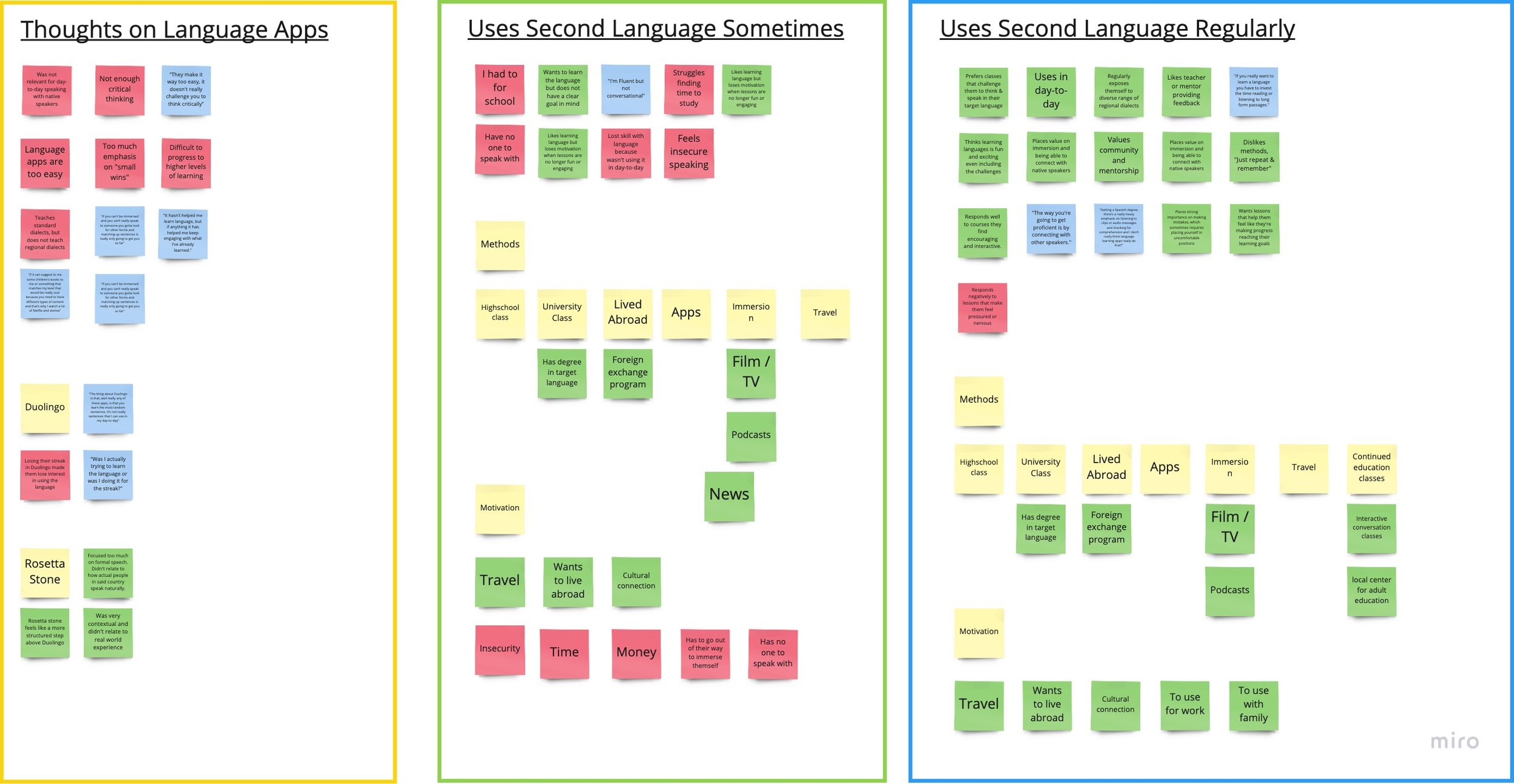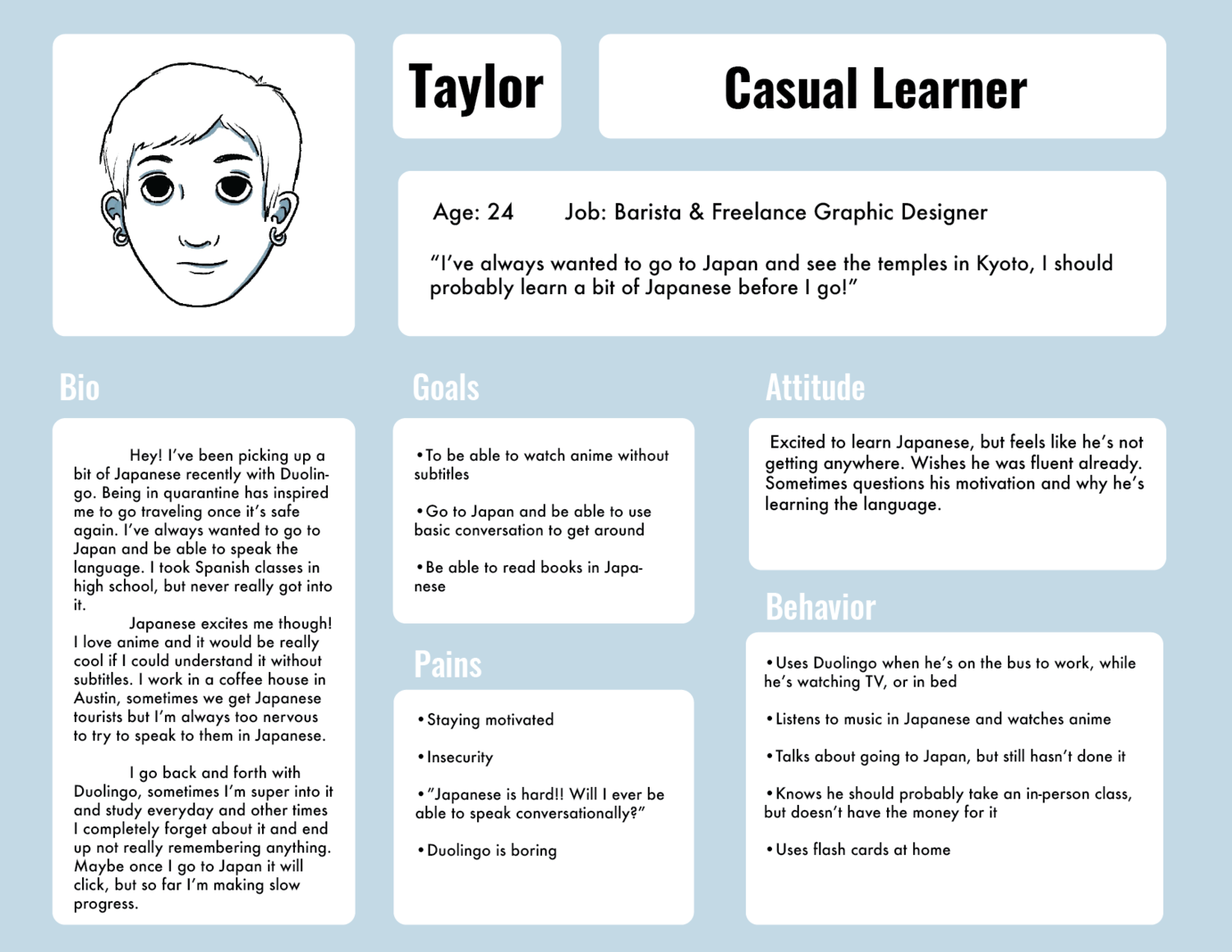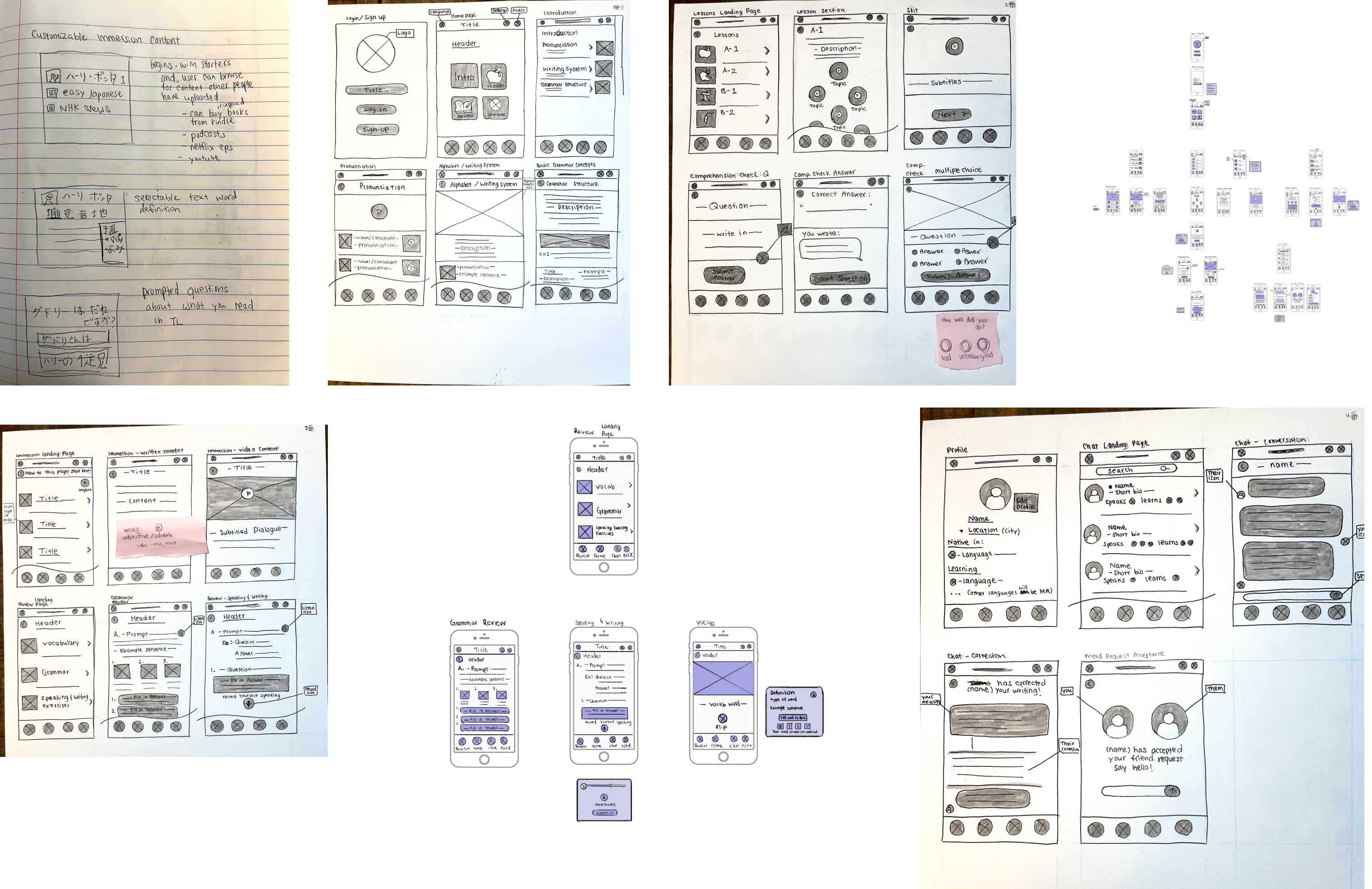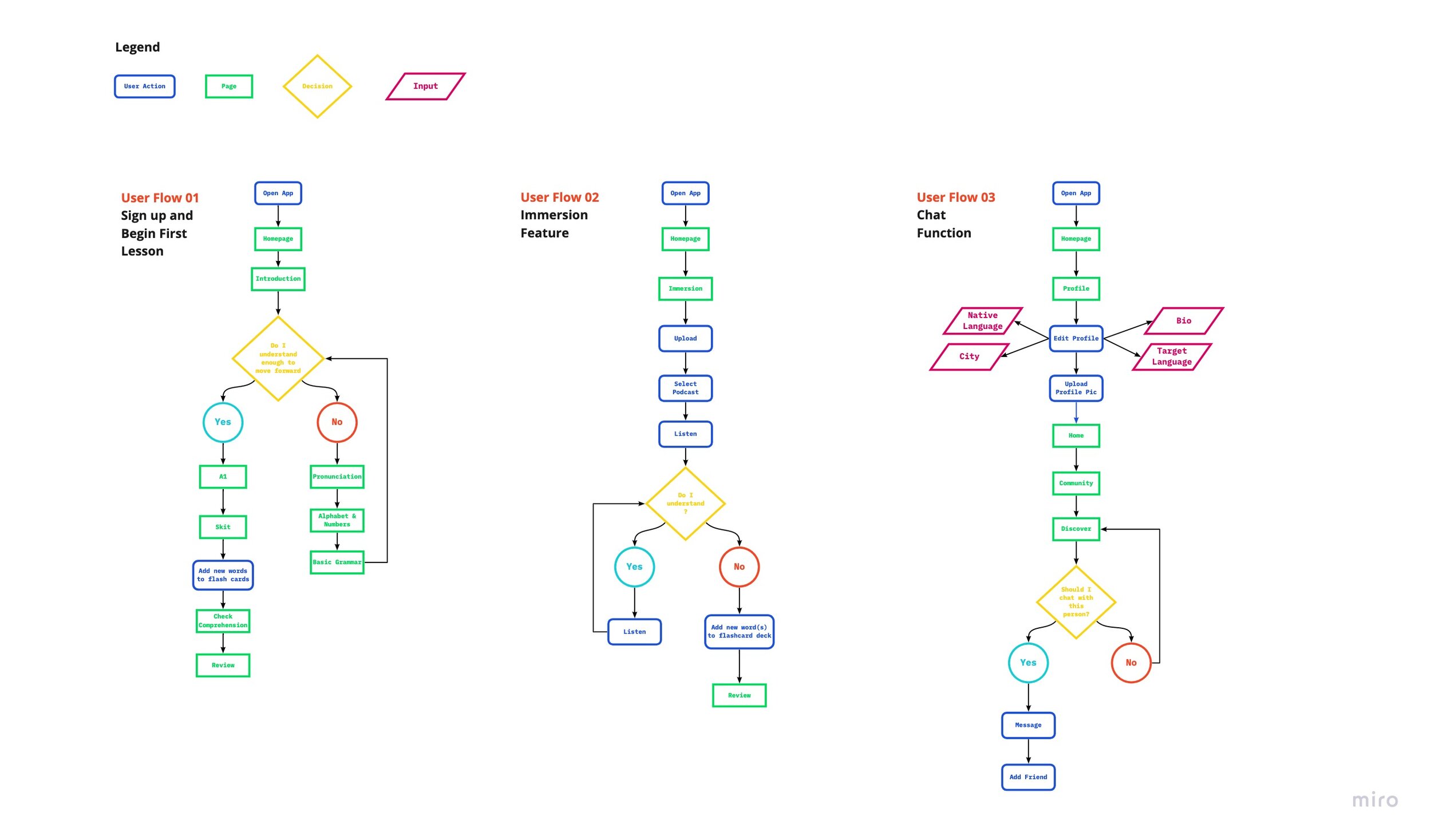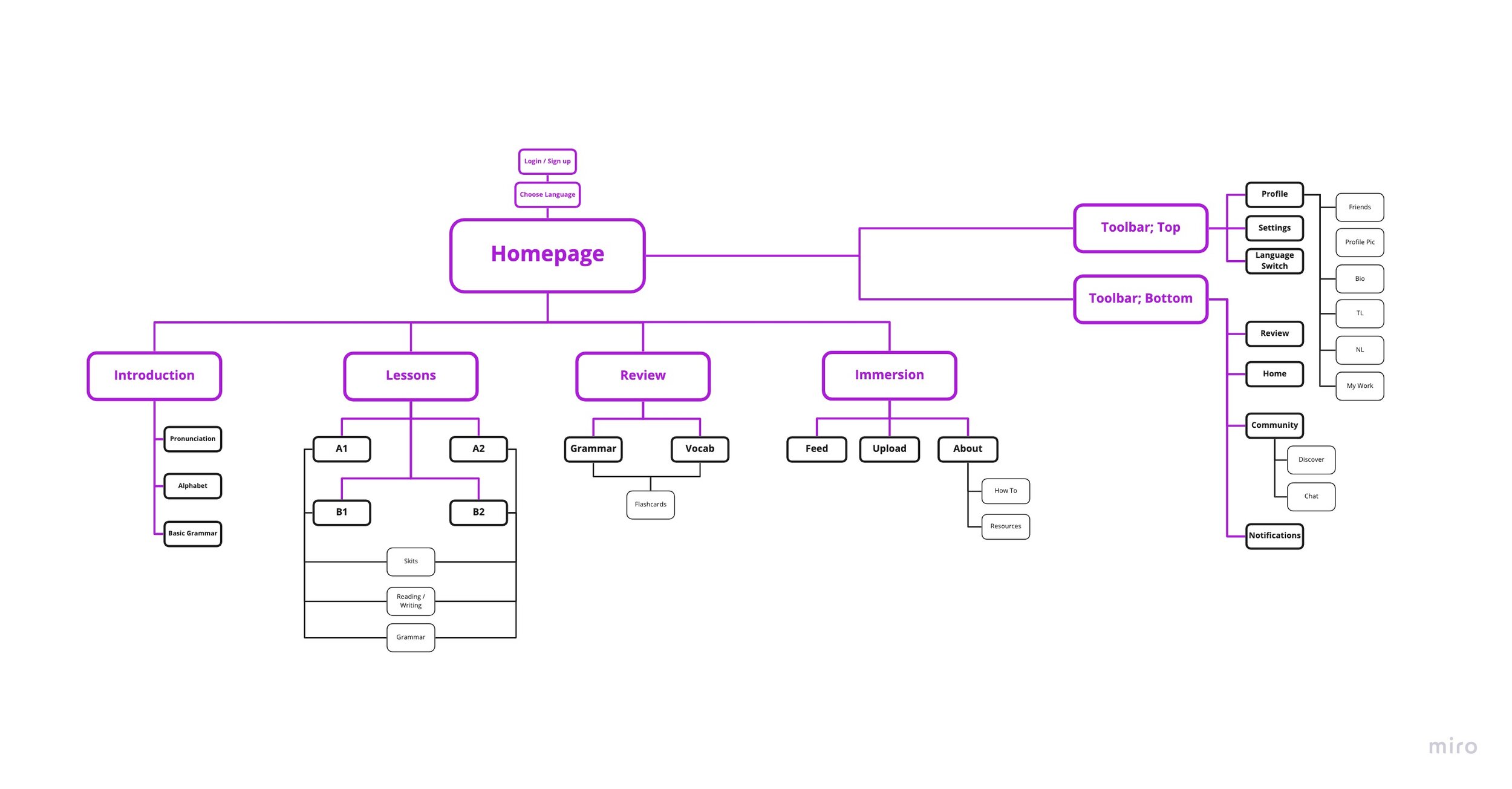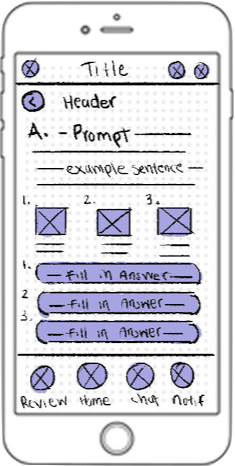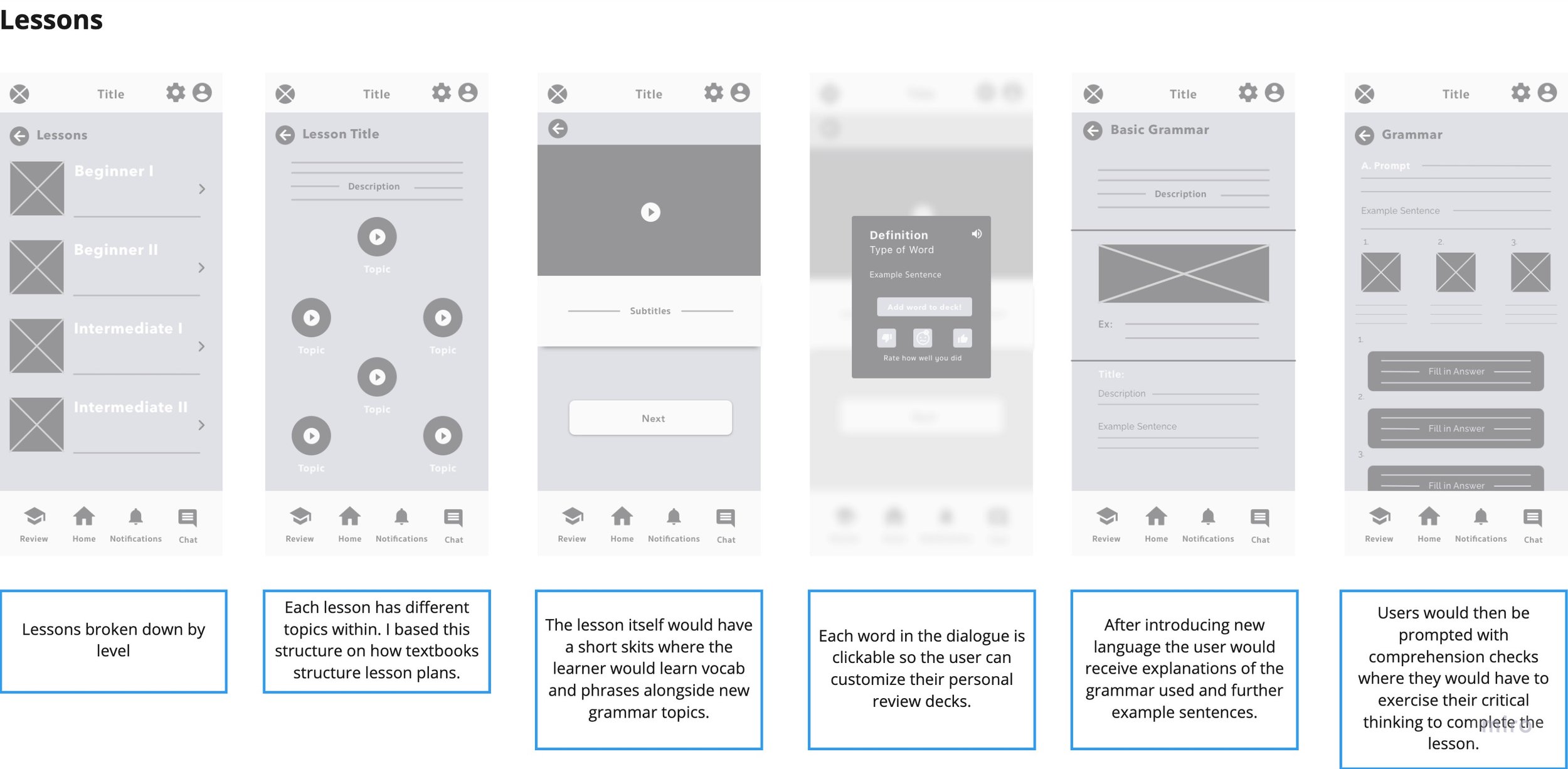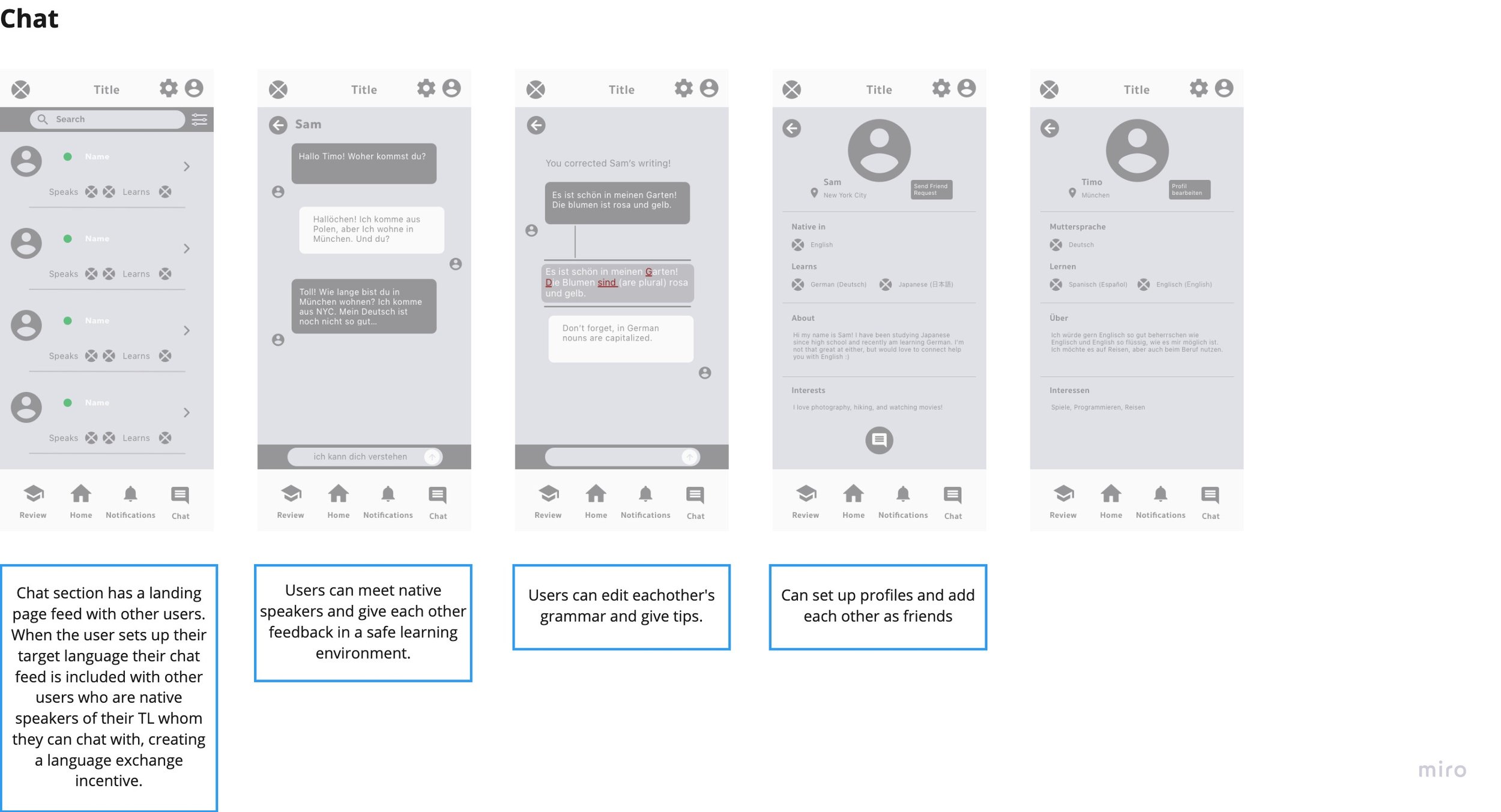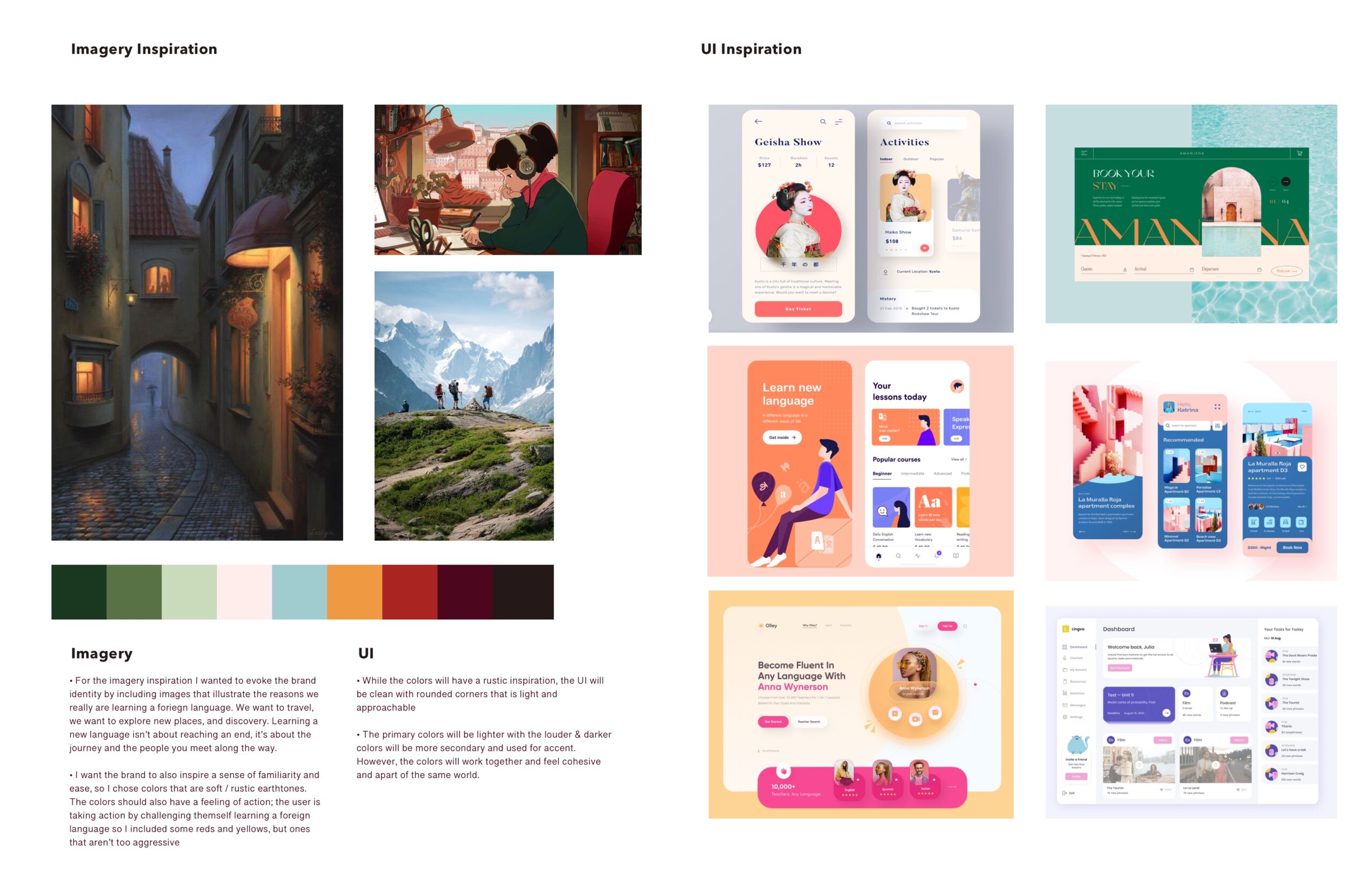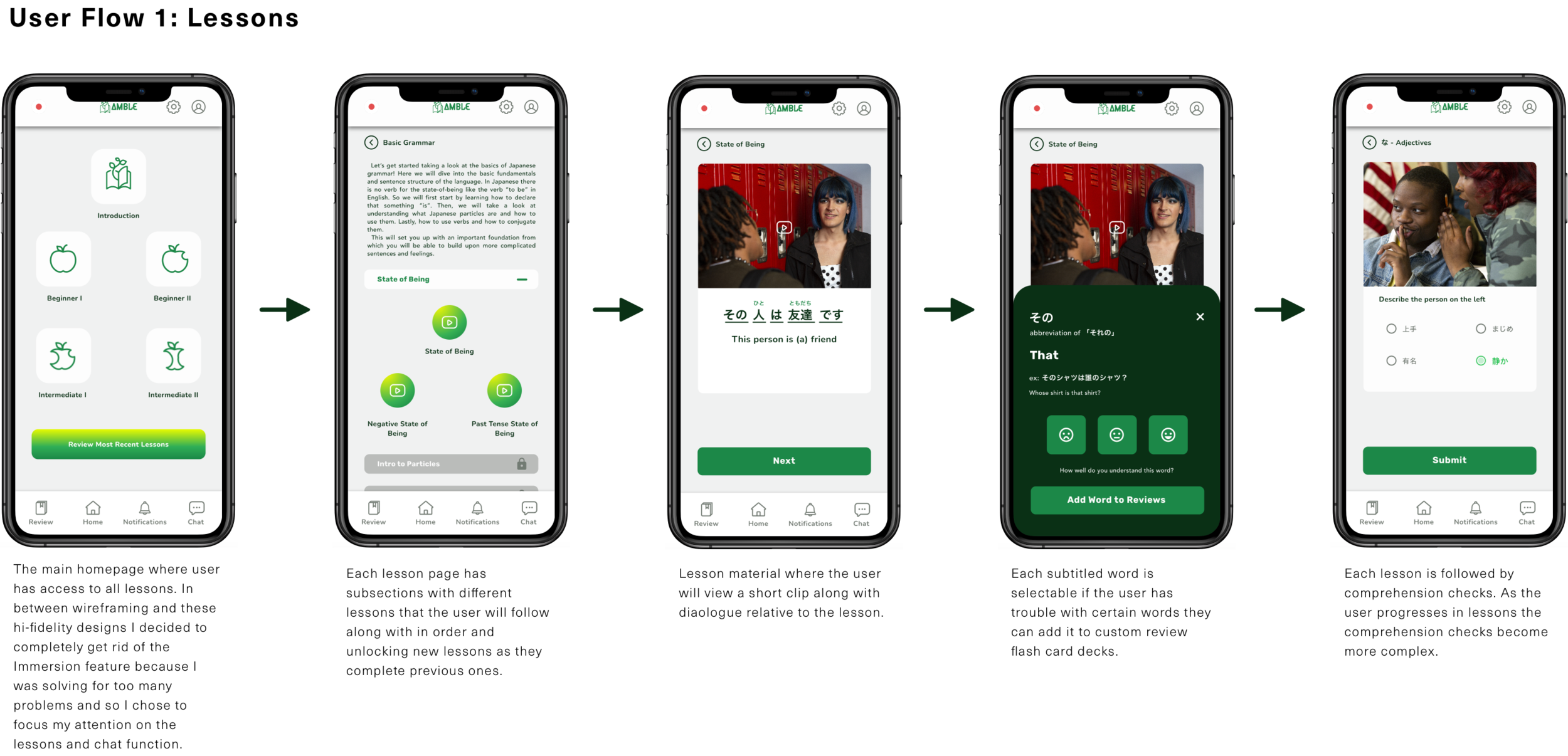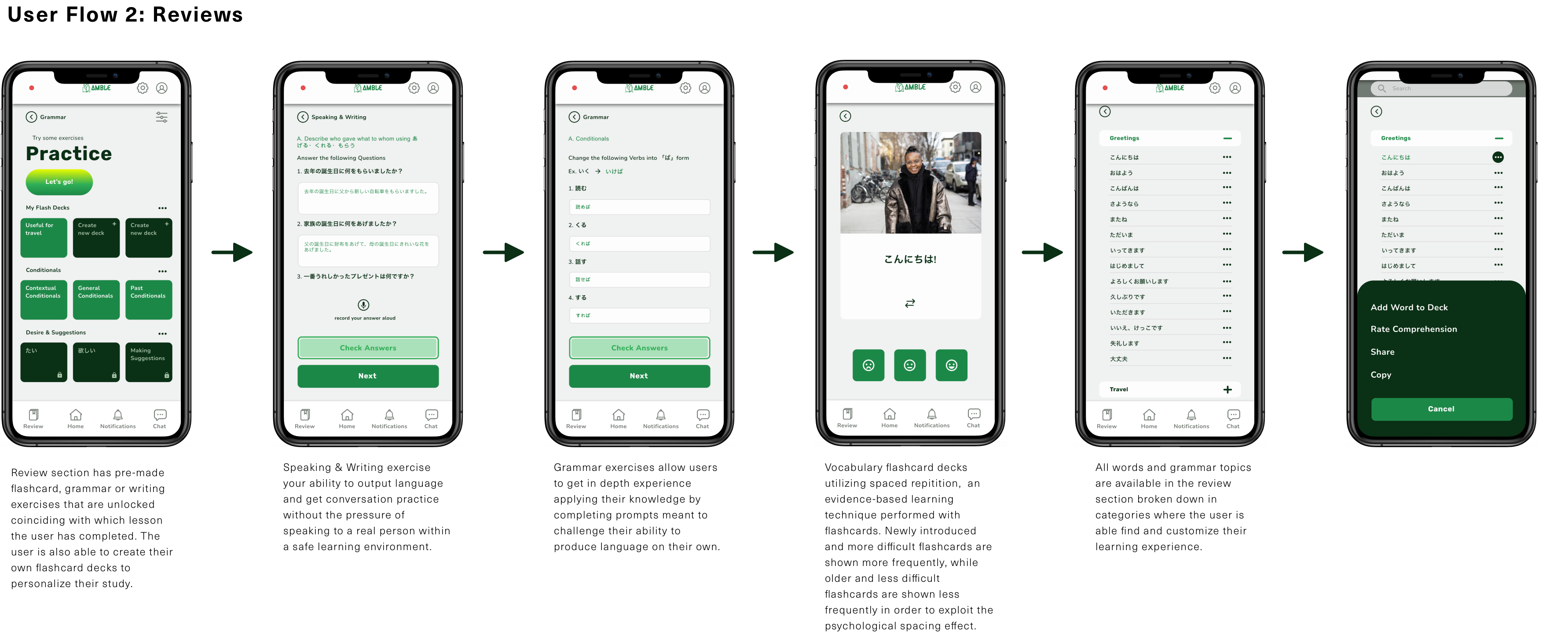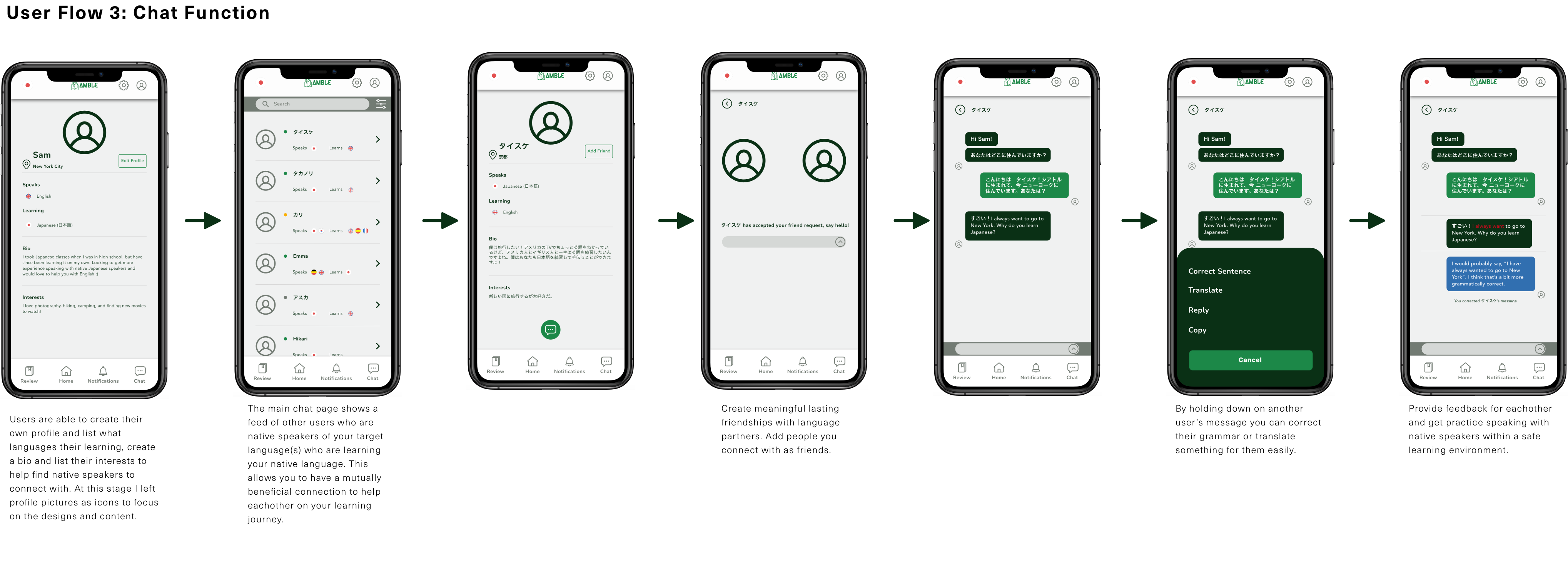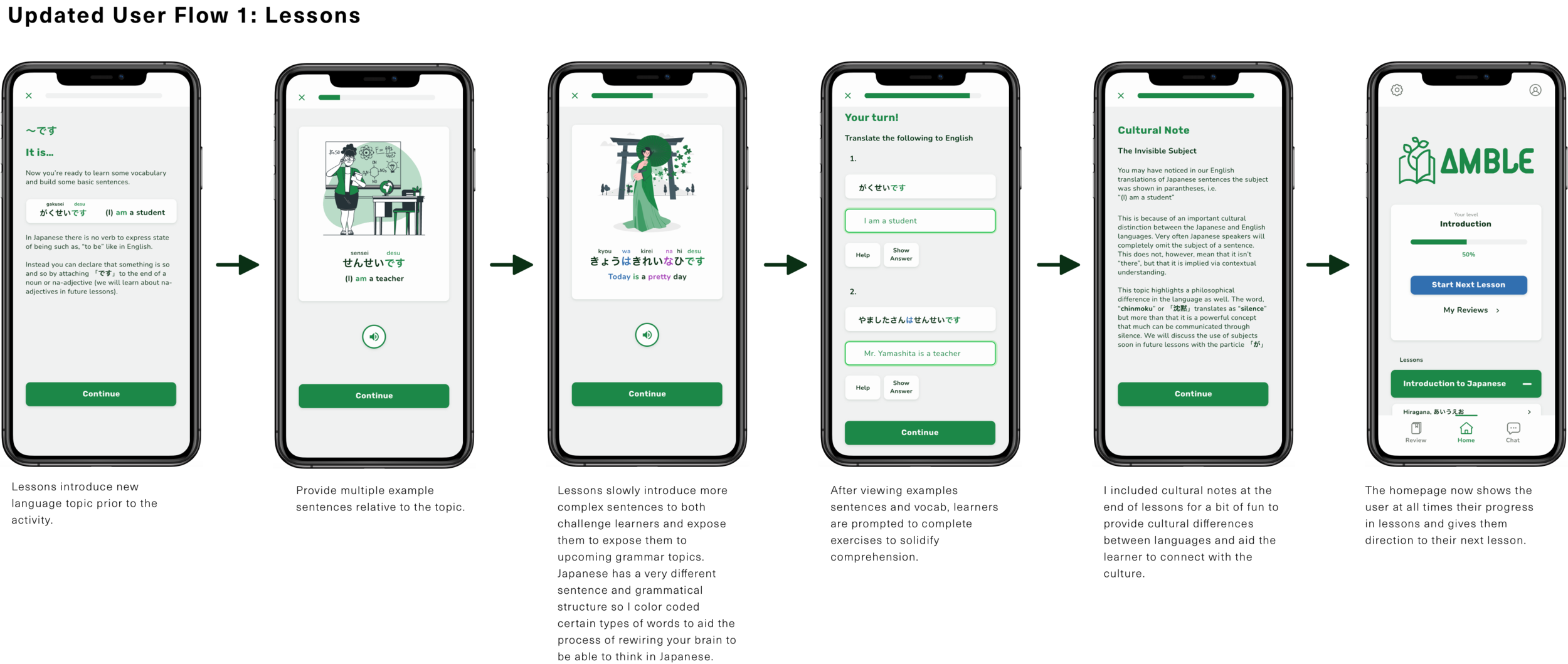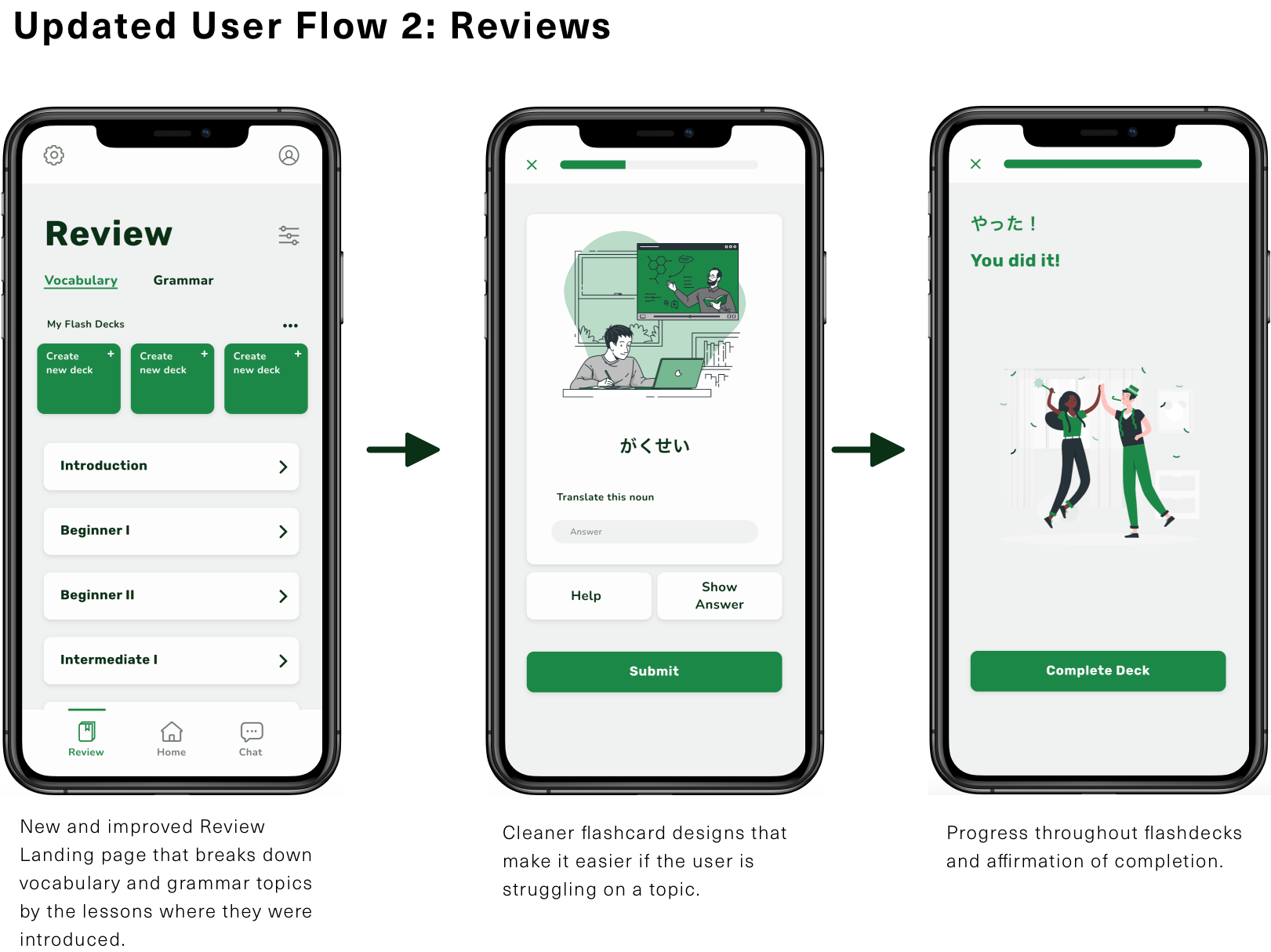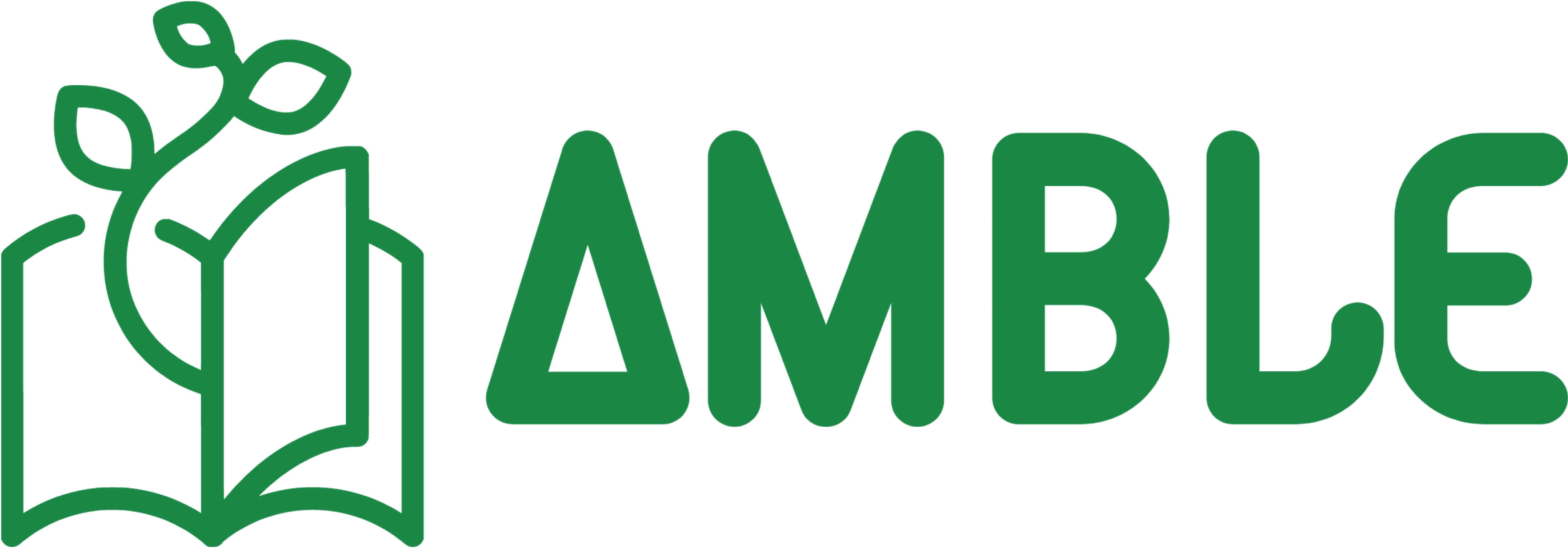
The language learning app that helps you acquire a second language by connecting you with language partners and building lasting relationships.
Amble is a language learning app I developed for my capstone project during my studies at Springboard. I created this product as a research proposal to examine how to actively acquire a second language in an organic way in order to further develop learners’ ability to build sentences on their own and communicate with native speakers effectively.
ROLE: UX Designer, UX Researcher, Information Architect, Content Strategist, and Visual Designer
PROJECT TYPE: IOS mobile app
TOOLS: Sketch, Invision, Miro, and Marvel
DURATION: 3 months
PROBLEM STATEMENT
Language learners want to be able to receive feedback from native speakers of the language and experience using the language with real people.
Language learning apps can be a great tool for users to learn new vocabulary and grammar, especially for beginner learners. However, getting any feedback on language learning apps tends to be restricted to whether the answer you provide is correct or not.
While this is helpful, this is not the sort of feedback language teachers and researchers advocate, as it does not explain why the answer is right or wrong.
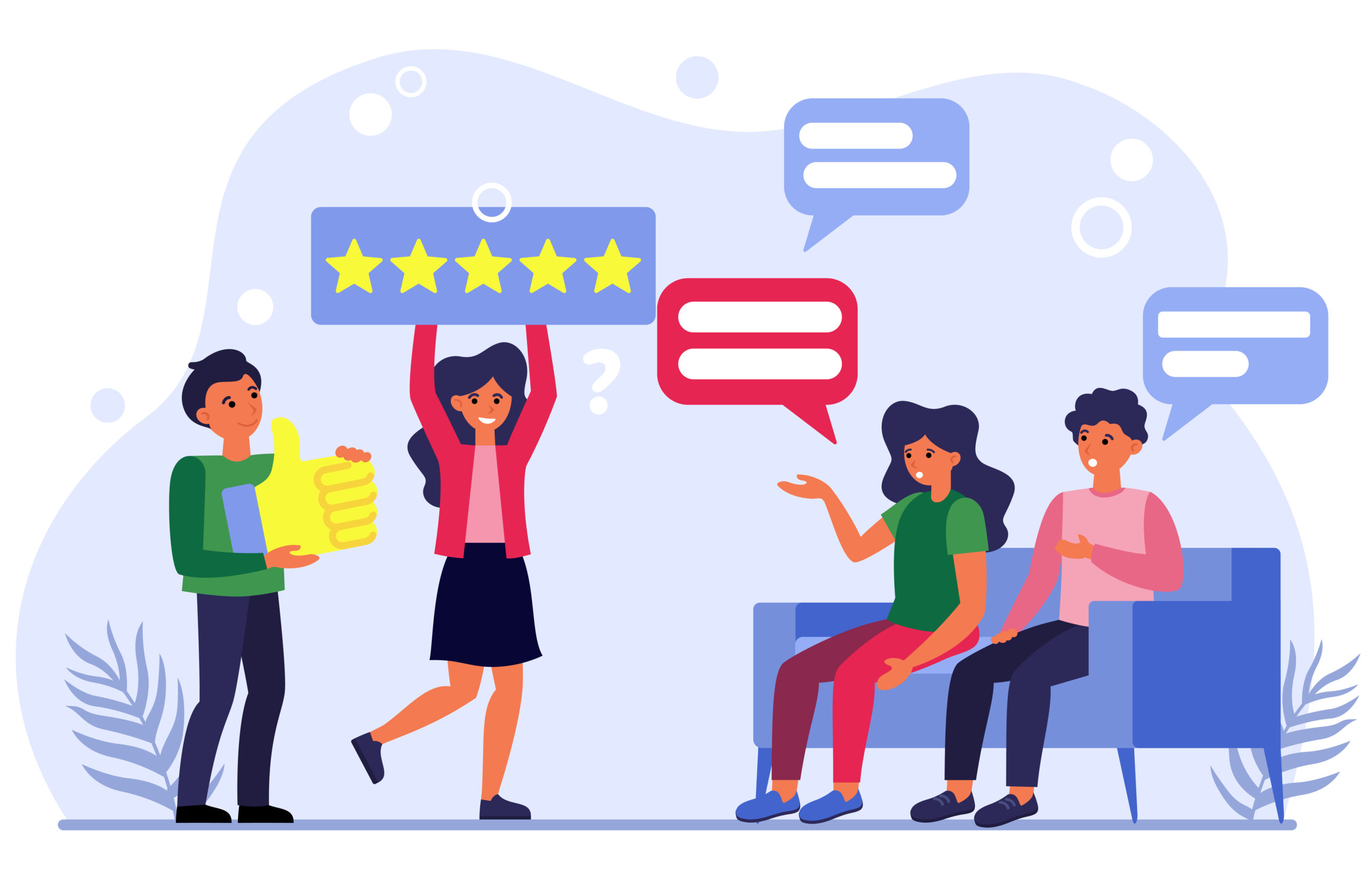
Project Background
Hypothesis 🧐
Reasoning 🤓
Providing learners with opportunities to engage both receptive & productive competencies by incorporating practice with native speakers alongside their lessons will improve their skills and confidence in using the language.
“Moving Past the Plateau: From Intermediate to Advanced Levels in Language Learning”
Learning takes place when learners encounter a gap in their linguistic knowledge of the second language. By noticing this gap, learners become aware of it and may be able to modify their output so that they learn something new about the language.
"The Comprehensible Output Hypothesis" by Merrill Swain
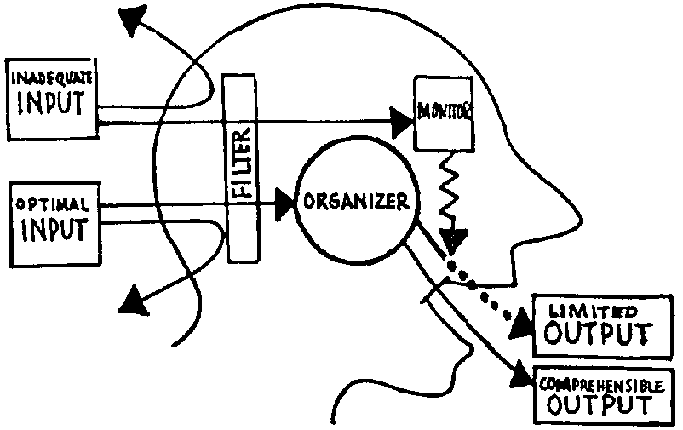
Research and Development
USER INTERVIEWS
I interviewed 5 people virtually with varied backgrounds of learning a second language, all of which had experience using language learning apps. I tested to identify specific constraints that hold back learners from achieving their language goals and the role of language apps in their practice.
KEY TAKEAWAY
None Of The Participants Felt Language Learning Apps Had Been Successful In Aiding Them To Reach Their Personal Learning Goals Or Advancing Their Language Skills.
- None of the participants felt that solely using a language learning app was adequate in their studies.
- 4 out of 5 participants expressed insecurity in speaking with native speakers.

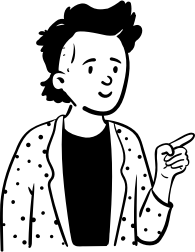

“Conversation is the best way to gain proficiency. The issue with apps is they don’t have a way of simulating conversation at all so it makes it really hard.”
“It hasn’t helped me learn the language, I think that there are better alternative resources out there, but if anything it has helped me keep up or engage things that I’ve already learned.”
“They make it way too easy, it doesn’t really challenge you to think critically.”
Secondary Research
Isolating where learning problems occur
In Dr. Jack C. Richard's essay, “Moving Past the Plateau: From Intermediate to Advanced Levels in Language Learning” he illustrates one of the most common problems in language acquisition is encountering a plateau in their learning, especially in moving from lower-intermediate to advanced levels.
Why is this happening?
There is a gap between receptive and productive competence.
“Language items which the learner recognizes and understands in the input he or she hears, do not pass into the learner’s productive competence (language he, she, or they can produce). I can read great novels for example, but I could never write one.”
How Do We Learn?
How Do We Retain New Information?
Neuroscientists discovered through brain-scanning technology that your brain works in two different ways. Dr. Barbara Oakley in her book, “Learning How To Learn”, calls these two modes of thinking, focused mode, and diffuse mode.
Spaced Repetition:
An evidence-based learning technique that is usually performed with flashcards. Newly introduced and more difficult flashcards are shown more frequently, while older and less difficult cards are shown less frequently in order to exploit the psychological spacing effect.
Process
COMPETITIVE ANALYSIS
I tested as many language-learning apps as possible and documented my findings.
I have been learning Japanese for 14 years and German for three; I have taken formal classes and independently learned on my own, and have tried nearly every language-learning app under the sun. I broke down the features and language learning strategies; I quickly found that they could be distilled into different categories based on their language learning strategies.
AFFINITY MAPPING
I began by synthesizing my findings with users by putting my key findings all on a wall, color-coded, and looking for patterns to help me identify connections between what I learned from users.
I quickly noticed by rearranging my findings that two core types of learning behaviors had emerged.
The difference between the two groups was the regularity they interacted with their target language. I broke them down into categories and also made a category of general thoughts users had about language apps that did not fit into either behavior type.
USER PERSONAS
In synthesizing my research I was able to identify two core user personas within the group of language learners I spoke with.
“Casual learners” whose study habits were less consistent and fluctuated depending on motivation and time constraints. “Inspired learners” who were actively engaging with their target language(s) regularly had stronger motivations and clearer goals. These learners had the same constraints and pain points, but “inspired learners” found ways to make studying interesting for themselves despite obstacles.
KEY INSIGHTS
Motivation Was The Key Factor That Differentiated The Two Personas.
Positive Association & Insecurity
- I noticed that casual learners had more doubts about their abilities and whether the effort would be worth the goals they were hoping to achieve.
- Inspired learners emphasized the importance of putting themselves in uncomfortable positions with native speakers as opportunities to grow.
- Inspired learners had the same frustrations, but positively associated their struggle as part of the experience and inspired them to get better.
- Casual learners were more commonly associating the idea of learning the language with the effort and felt uncertain whether they would ever be able to feel comfortable speaking.
Design
Comprehensible Input:
- Lessons in the form of short story ideo skits - animated or live-action clips
- Lessons that follow a storyline throughout the course
- Feature to upload Kindle books in your target language
Comprehensible Output:
- Social media feature where you can chat with users or match you with language partners based on learning goals.
- Users set their native language and target language(s) and are shown a feed of learners who are native in their target language and learning the others' native language providing incentive for connection
INFORMATION ARCHITECTURE
I took my ideas from sketch to building out three red routes & user flows:
- Sign-up flow + lesson
- Immersion feature
- Chat function
SITEMAP
TESTING LOW-FIDELITY PROTOTYPE
I adjusted my sketches after tightening up my ideas by building out the information architecture and digitally rendering my sketches. I then developed the designs into a lo-fi prototype that I tested with five users to discover if the user flows were working.
Key Insights
- I realized that the immersion function I created was biting off more than I could chew and could be its own app - which already exists (LinQ).
- Users had an overwhelmingly positive response to the chat function.
- Not having actual lessons written out yet made it difficult to test if they made sense. I would have to write out by hand my own lessons in the next iteration.
WIREFRAMES
I scrapped the immersion function and decided to focus on two main user flows as my MVP to develop; video lessons (input) and social elements (output).
TESTING WIREFRAMES
I tested my wireframes again with another group of five participants under similar conditions to see if the direction I was going in was working better.
Key Insights:
- Without the immersion feature, as well as, condensing pages I was able to reduce user confusion.
- It was still very difficult to test the lessons without having finished lessons written out, which I was working on but was very time consuming.
Visual Design
Amble: To walk or move at a slow, relaxed pace.
I chose this name for my product because the purpose of learning a second language is not to reach an immeasurable goal of complete fluency. It’s about the journey and the people you meet along the way. My brand vision harkens back to my research phase; utilizing the diffuse mode of users’ brains when we are relaxed we are able to learn new information more effectively. I made my design choices to be reflective of the exciting aspects of learning a new language and experiencing a new culture; to remind the user why they chose this path in the first place.
ITERATION
I wrote the first draft of lessons that I created using my own knowledge and experience learning Japanese formally in school.
I used a mixture of my own knowledge of elementary Japanese alongside several texts and resources. After finalizing the first draft I incorporated them into my first iteration of high fidelity mockups.
Testing + Development
After creating the first iteration of high-fidelity mockups and a working prototype, I conducted usability tests with six user participants. The feedback I received made it immediately clear what changes were necessary.
KEY INSIGHTS
Too Information-Heavy
I was throwing too much new information at the User. Long-form explanations of language topics overwhelmed users.
Pages Were Too Deeply Nested.
Resulting in users getting lost and uncertain about how to get back to where they wanted to go.
Progress In Lessons Was Unclear.
Users expressed a desire to have more indication represented in their progress during lessons and review exercises.
Final Designs
Changes I made and why
Visual Design
I completely overhauled the visual design of my first iteration; I felt that my visual design had suffered from placing most of my focus on creating content and lessons.
Lessons
Due to the worsening conditions of the pandemic and time constraints, I was no longer able to film actual live-action skits for lesson content with native Japanese speakers as I had planned.
- I used illustrations in the placement of video content.
- Lessons now have more clear and concise directions, progress, and engaging exercises.
Condensed Pages
Condensed Pages made navigation more efficient allowing the user to get where they need to in as few clicks as possible.
Prototyping and Final Testing
I built my designs into a functioning prototype and tested the designs with a new group of seven participants.
I measured my success by testing for errors and whether users were experiencing the same (or new) pain points as before. I also tested whether I could introduce users to the Japanese language and if by the end of lessons they could complete the lessons and reviews correctly to see if I could actually teach them Japanese with this application.
Results
🌟 5 out of 7 users answered all 8 questions correctly
🌟 85% of users could build a basic sentence based on the lesson material
🤞None of the users expressed the same pain points that the first iteration had
👎Grammar explanations were still overwhelming for users (4 out of 7)
👩🏻🦰 “Wow, I feel like I learned a lot about Japanese that I didn’t know 20 minutes ago”
👦🏾 "I have never seen a language app do this before, this would be a huge sell for me”
Conclusion
This project was less about, “can I solve the problems with language learning apps?” and more a research proposal to understand why these problems exist in the first place and how we can engage learners more effectively and utilize methods that are more organic to the human experience of natural language acquisition.
So if you were to ask me, “did you solve the problem and improve users’ speaking and writing skills?” I would say, not necessarily and that wasn’t the point. Some of the features of the app I built already exist in some app or another, but I took the best-of-the-best out there backed by current linguistic research, as well as my own, I put them together into one app and tested these ideas. So did that work? Yes, testing these ideas with users had more of a positive response than I expected based on my own metrics. What I did was create a proposal for a new way to approach independent language learning and in that way I would consider this project a success. If I had more time to really get into it even further, I would need to continue further testing; preferably in the form of long-form journal studies with users, but unfortunately, that was not within the scope of the project this time around.
This is a subject I feel passionately about and I plan on continuing to iterate on it in the future :) When I do so my next steps will be:
- Create animated or live-action short skits in place of illustrations based on continual storylines that introduce language to users
- Do journal studies with users to test the longterm efficacy of updated lessons
